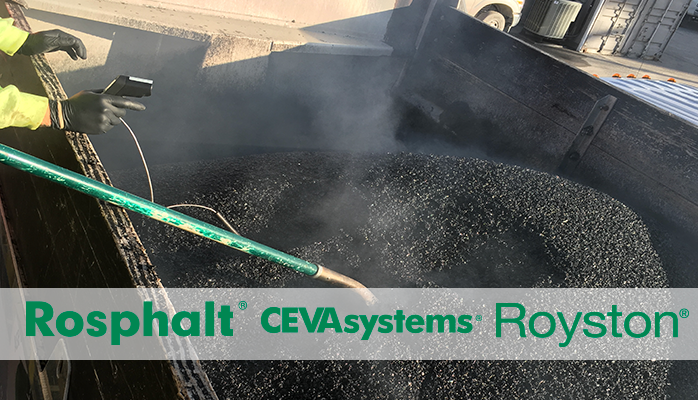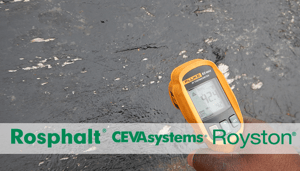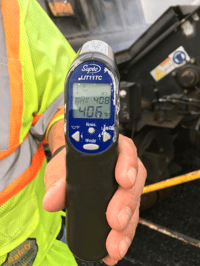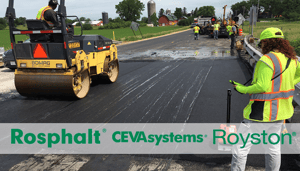One of the critical elements in a successful paving project is the asphalt mix design. Another term...
The Importance of Temperature Monitoring in Asphalt Paving

It is well known in the asphalt-paving industry that the correct temperature of a finished asphalt mixture is vital to achieving a high-quality, long-lasting pavement. However, there are other environmental factors that must be taken into consideration, such as
- ambient (air), temperature
- substrate (base) temperature
- wind conditions and velocity
- haul time from the asphalt plant to the bridge deck.
All of these factors in combination with the mix design and quality control of the overall production and placement processes of the asphalt mixture are keys to achieving a proper density of the finished asphalt pavement.
Asphalt mix temperatures and viscosity are inversely correlated
 When an asphalt mix temperature is high, the viscosity, or stiffness, tends to be lower. As the temperature drops off or cools, the viscosity of the mix increases. This relationship is why it is vital to ensure temperatures are within the proper specified range to achieve optimal compaction or density of the finished pavement.
When an asphalt mix temperature is high, the viscosity, or stiffness, tends to be lower. As the temperature drops off or cools, the viscosity of the mix increases. This relationship is why it is vital to ensure temperatures are within the proper specified range to achieve optimal compaction or density of the finished pavement.
Standard/unmodified HMA (hot mix asphalt) mixes are produced in the range of 275 – 350°F. Depending on environmental factors discussed earlier, mixes can lose 10 – 50°F during transport from the plant to the job site, and through the paver onto the bridge deck. As much as 2/3 of the temperature loss of a mix can be attributed to the bridge deck and ambient temperature conditions. Normally, agencies (DOTs) specify that paving should not be performed unless the ambient temperatures are 40-50°F and rising. Both deck temperatures and wind conditions need to be considered as well as travel time from the plant to the job site.
Monitor environmental conditions
 The temperature of an asphalt mix after it passes through the paver is important to know when considering how much time is available for proper compaction. When air and deck temperatures are lower than the specified conditions, the asphalt mix will tend to cool rapidly, causing the mix to become stiff there by impeding compaction. Thin lift applications cool faster than thicker lifts due to a lower mass of material available. Where proper compaction (density) is not achieved, asphalt pavements tend to ravel (similar to spalled concrete) quickly, leaving rough, rocky surfaces that retains water and leads to shorter service life than intended. To avoid these pitfalls, it is important to monitor all environmental conditions during the paving operation.
The temperature of an asphalt mix after it passes through the paver is important to know when considering how much time is available for proper compaction. When air and deck temperatures are lower than the specified conditions, the asphalt mix will tend to cool rapidly, causing the mix to become stiff there by impeding compaction. Thin lift applications cool faster than thicker lifts due to a lower mass of material available. Where proper compaction (density) is not achieved, asphalt pavements tend to ravel (similar to spalled concrete) quickly, leaving rough, rocky surfaces that retains water and leads to shorter service life than intended. To avoid these pitfalls, it is important to monitor all environmental conditions during the paving operation.
There are a couple of ways to help neutralize some of the negative effects of temperature loss when paving in less than ideal conditions. The use of a material transfer vehicle (MTV) helps to re-blend the material prior to dumping it into the paver. This assists with two aspects of the mixes:
- First, it helps ensure the homogeneous and non-segregated mix is delivered prior to paving.
- Second, when equipment is hot from the transfer of previous loads, the MTV can also help to create a uniform higher temperature in the mix traveling through it, which creates, in turn, a uniform window of compaction for the roller operators and team checking/monitoring in-place densities.
Another practice that can assist in ensuring optimal compaction is maintaining a safe but close distance with the breakdown and intermediate/finish roller. Having the breakdown (first in line) roller close behind the paver makes sure the initial compaction occurs when the mix is at its temperature. This is a vital step in the process of achieving optimal density and optimal performance of the pavement.
 When properly monitored, pavement temperatures provide the quality control team (roller operators and density monitors) a basis for determining the rolling patterns needed to achieve an optimal density of the mat. And, in turn, deliver an optimal performance of the asphalt pavement on a project. This is not the only temperature that is important to monitor, however. Ambient temperatures, deck temperatures and wind conditions play crucial roles in the success or failure e, long-lasting pavements. This is a process that can be repeated project after project. When combined with a good mix design and good paving practices, these monitoring techniques create a winning combination for the agency/owner, contractor and general public.
When properly monitored, pavement temperatures provide the quality control team (roller operators and density monitors) a basis for determining the rolling patterns needed to achieve an optimal density of the mat. And, in turn, deliver an optimal performance of the asphalt pavement on a project. This is not the only temperature that is important to monitor, however. Ambient temperatures, deck temperatures and wind conditions play crucial roles in the success or failure e, long-lasting pavements. This is a process that can be repeated project after project. When combined with a good mix design and good paving practices, these monitoring techniques create a winning combination for the agency/owner, contractor and general public.
Chase Corporation’s Bridge and Highway products are uniquely designed to enhance the performance of bridges, highways, parking structures, and other elevated structures while extending the lives of pavements, reducing maintenance costs and improving durability. Rosphalt additives, Royston Membranes, and CEVA Expansion Joint Systems are product lines that deliver high performance and reliability in the most demanding conditions. These products can be used in a variety of applications.
Please see contact Chase Corporation for additional information.







